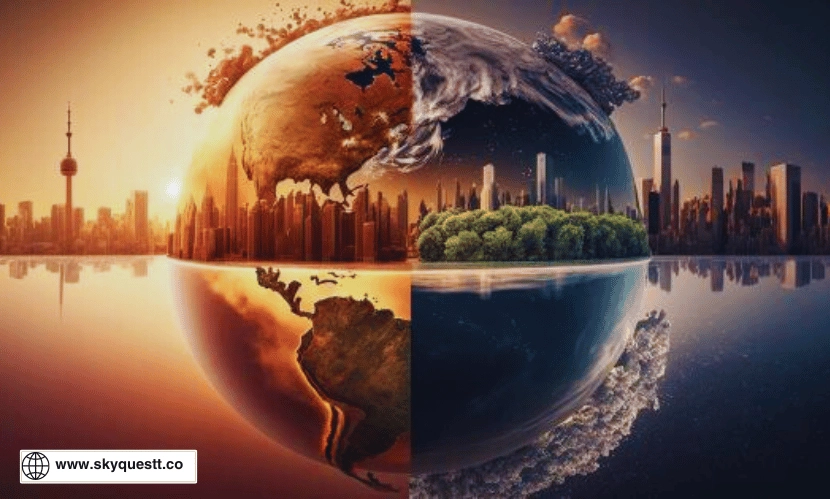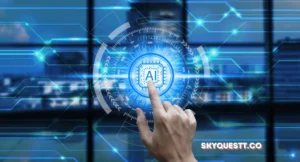
Global warming stands as one of the most pressing challenges our planet faces today. The effects are increasingly visible, with rising temperatures, melting ice caps, and a surge in extreme weather events. However, addressing this crisis is far from simple. The journey toward meaningful action is fraught with significant hurdles, particularly economic and political/social challenges. These factors complicate global efforts to mitigate the impacts of climate change. In this blog post, we will explore these constraints in detail and examine how they shape the ongoing battle against global warming.
Economic Constraints
Addressing global warming is undeniably complex, and one of the most significant challenges lies in the economic costs tied to implementing sustainable practices.
High Costs of Green Technology
- Transitioning to a low-carbon economy demands a considerable investment in green technology and infrastructure. While renewable energy sources like wind, solar, and hydropower are essential for cutting greenhouse gas emissions, they require significant upfront capital. For instance, in 2022, the global average cost to install 1 megawatt (MW) of solar photovoltaic (PV) systems was around $850,000. Similarly, wind turbine installations can range from $1.3 million to $2.2 million per MW, varying by location and turbine type
- Developing countries are particularly challenged by these costs due to their limited financial resources. The World Bank estimates that to achieve their climate goals, developing nations would need to invest roughly $4 trillion by 2030. This financial strain often deters these countries from committing to large-scale green projects, especially when they are already grappling with economic instability and poverty.
Impact on Industry and Jobs
- Another economic challenge is the potential disruption to industries and jobs as economies move away from fossil fuels. The fossil fuel sector is a significant economic driver in many countries, providing employment to millions globally. For instance, in 2020, the coal industry in the United States employed about 42,000 people. However, as the world pivots toward renewable energy, these jobs face the threat of obsolescence.
- This shift can cause economic upheaval, especially in regions heavily reliant on fossil fuel industries. The decline of coal in West Virginia, for example, has led to economic difficulties and a notable increase in unemployment. Reskilling workers and transitioning them to new sectors adds to the economic burden, fueling resistance to climate policies that could jeopardize existing jobs.
Short-term vs. Long-term Economic Gains
- There is also a tension between the immediate economic advantages of traditional energy sources and the long-term benefits of sustainable practices. Fossil fuels like coal, oil, and natural gas remain cheaper and more accessible than renewable energy, making them the favored choice for many industries and consumers.
Political and Social Constraints
Political and social challenges significantly hinder global efforts to effectively mitigate global warming.
Political Will and Global Cooperation
- One of the most formidable obstacles to combating global warming is the lack of political will and the difficulty in achieving global cooperation. While the Paris Agreement in 2015 was a landmark step towards unified climate action, disparities in national commitments have emerged. Some countries, particularly those with robust fossil fuel industries, are hesitant to adopt aggressive emission reduction targets due to the potential economic repercussions.
- As of 2023, only 70 nations had updated their Nationally Determined Contributions (NDCs) to align with the goal of limiting global warming to 1.5°C above pre-industrial levels. In contrast, major emitters like China and India have been criticized for setting relatively modest targets, driven by their concerns over economic growth and energy security.
- Moreover, political interests and lobbying by powerful industries complicate the implementation of effective climate policies. For example, in 2022, the fossil fuel industry in the United States spent over $250 million on lobbying efforts to influence climate legislation in their favor. This political influence often leads to diluted policies that fall short of addressing the urgency of the climate crisis.
Public Perception and Awareness
- Public perception and awareness are critical in shaping climate policies, yet they often pose significant barriers to progress. Misinformation and climate change denial remain pervasive, undermining efforts to build widespread support for urgent action. A 2022 survey by the Pew Research Center revealed that only 60% of Americans viewed climate change as a major threat, with political affiliation playing a significant role in shaping these perceptions.
- The spread of misinformation, particularly through social media, fuels skepticism about climate science and the necessity of immediate action. False claims, such as the notion that global warming is merely a natural phenomenon or that renewable energy is unreliable, continue to circulate, weakening the push for stronger climate policies.
- Additionally, altering public behavior and consumption patterns is challenging, especially when it involves sacrifices like higher energy costs or lifestyle changes. For example, reducing meat consumption—a significant contributor to global greenhouse gas emissions—faces resistance due to cultural preferences and ingrained dietary habits.
Social Equity and Justice
- Global warming exacerbates existing inequalities, disproportionately impacting vulnerable communities, raising critical concerns about social equity and justice. Low-income communities, indigenous peoples, and developing countries often bear the brunt of climate change impacts, despite contributing the least to the problem.
- For instance, the Pacific island nation of Kiribati is grappling with existential threats from rising sea levels, with predictions suggesting that parts of the country could become uninhabitable by 2050. In the United States, marginalized communities in regions like Louisiana’s “Cancer Alley” are disproportionately exposed to pollution and extreme weather events.
- Addressing climate change without considering social equity and justice can worsen these inequalities. For example, while carbon pricing policies are effective in reducing emissions, they can disproportionately burden low-income households if not designed with fairness in mind. Ensuring that climate action is inclusive and equitable is essential for garnering broad support and achieving sustainable outcomes.
Human Capacity Constraints
- Human capacity plays a crucial role in shaping our ability to adapt to and mitigate the effects of climate change. However, various limitations in individual and societal capabilities present significant obstacles.
Individual Capabilities
- Human psychology and behavior often act as barriers to effective climate adaptation. Simply knowing about climate change doesn’t always translate into action. Many people hear about climate issues, but this awareness alone rarely leads to meaningful behavioral changes. This highlights the importance of not just knowledge transfer, but also how technical and scientific topics are communicated. Emotional communication around climate change can be a powerful tool in motivating individuals to take action.
- However, grasping the complexity of climate change and identifying truly effective measures is challenging. As one interviewee pointed out, “there are probably many limits to adaptation, but it is probably impossible to say which ones yet.” This suggests that our imagination and understanding are limited, leading to uncertainty about the best course of action in an unpredictable future. Ineffective measures can give individuals a false sense of accomplishment, hindering further action. For example, distributing information brochures about climate change may create the impression that something meaningful has been done, allowing individuals to feel the issue is resolved without addressing deeper questions or taking further action.
Societal Capabilities – Systemic Risk
- On a broader scale, societal capabilities are constrained by systemic risks, which often stem from the way our social systems are organized. The COVID-19 pandemic serves as a stark example of how such risks can exacerbate the limits to adaptation. During the pandemic, resources and capacities were redirected to manage the health crisis, leaving fewer resources available to address simultaneous climatic hazards. This lack of preparedness can significantly hamper our ability to respond effectively to climate-related challenges.
- When critical infrastructure, like healthcare or electricity, is compromised, the ripple effects can create large-scale issues that are difficult to manage. The damage goes beyond the immediate loss of a building or structure and can affect other parts of the system. These constraints also exist on an individual level, where people may face multiple stressors at once, such as losing their job, caring for a sick family member, and losing their home due to an extreme weather event. This accumulation of stressors can overwhelm an individual’s capacity to adapt, highlighting the interconnectedness of societal and individual vulnerabilities in the face of climate change.






